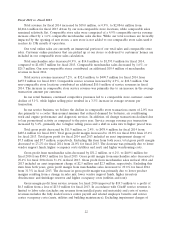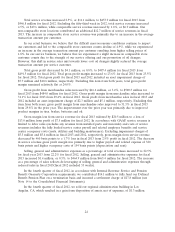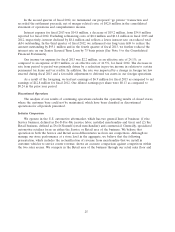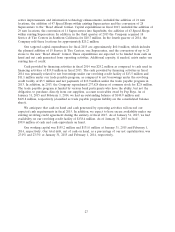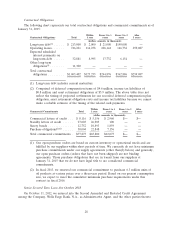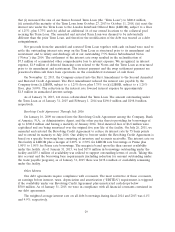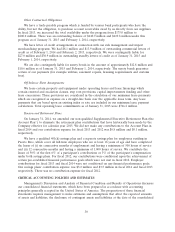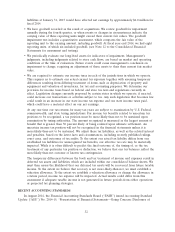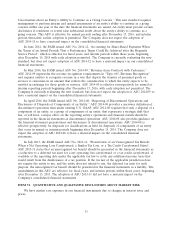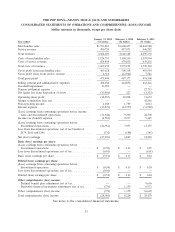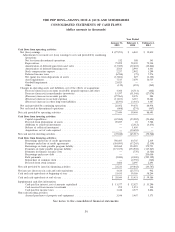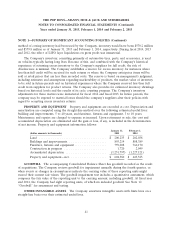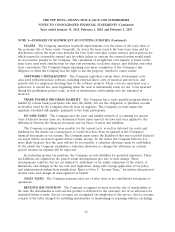Pep Boys 2014 Annual Report Download - page 38
Download and view the complete annual report
Please find page 38 of the 2014 Pep Boys annual report below. You can navigate through the pages in the report by either clicking on the pages listed below, or by using the keyword search tool below to find specific information within the annual report.liabilities at January 31, 2015 would have affected net earnings by approximately $6.0 million for
fiscal 2014.
• We have goodwill recorded as the result of acquisitions. We review goodwill for impairment
annually during the fourth quarter, or when events or changes in circumstances indicate the
carrying value of these reporting units might exceed their current fair values. The goodwill
impairment test includes a quantitative assessment, which compares the fair value of the
reporting unit to the carrying amount, including goodwill. At fiscal year end 2014, we had eight
reporting units, of which six included goodwill. (see Note 12 to the Consolidated Financial
Statements for assessment and testing).
• We periodically evaluate our long-lived assets for indicators of impairment. Management’s
judgments, including judgments related to store cash flows, are based on market and operating
conditions at the time of evaluation. Future events could cause management’s conclusion on
impairment to change, requiring an adjustment of these assets to their then current fair market
value.
• We are required to estimate our income taxes in each of the jurisdictions in which we operate.
This requires us to estimate our actual current tax exposure together with assessing temporary
differences resulting from differing treatment of items, such as depreciation of property and
equipment and valuation of inventories, for tax and accounting purposes. We determine our
provision for income taxes based on federal and state tax laws and regulations currently in
effect. Legislation changes currently proposed by certain states in which we operate, if enacted,
could increase our transactions or activities subject to tax. Any such legislation that becomes law
could result in an increase in our state income tax expense and our state income taxes paid,
which could have a material effect on our net earnings.
At any one time our tax returns for many tax years are subject to examination by U.S. Federal,
commonwealth, and state taxing jurisdictions. For income tax benefits related to uncertain tax
positions to be recognized, a tax position must be more-likely-than-not to be sustained upon
examination by taxing authorities. The amount recognized is measured as the largest amount of
benefit that is greater than 50 percent likely of being realized upon ultimate settlement. An
uncertain income tax position will not be recognized in the financial statements unless it is
more-likely-than-not to be sustained. We adjust these tax liabilities, as well as the related interest
and penalties, based on the latest facts and circumstances, including recently published rulings,
court cases, and outcomes of tax audits. To the extent our actual tax liability differs from our
established tax liabilities for unrecognized tax benefits, our effective tax rate may be materially
impacted. While it is often difficult to predict the final outcome of, the timing of, or the tax
treatment of any particular tax position or deduction, we believe that our tax balances reflect the
more-likely-than-not outcome of known tax contingencies.
The temporary differences between the book and tax treatment of income and expenses result in
deferred tax assets and liabilities, which are included within our consolidated balance sheets. We
must then assess the likelihood that our deferred tax assets will be recovered from future taxable
income. To the extent we believe that recovery is not more-likely-than-not, we must establish a
valuation allowance. To the extent we establish a valuation allowance or change the allowance in
a future period, income tax expense will be impacted. Actual results could differ from this
assessment if adequate taxable income is not generated in future periods from either operations
or projected tax planning strategies.
RECENT ACCOUNTING STANDARDS
In August 2014, the Financial Accounting Standards Board (‘‘FASB ’’) issued Accounting Standard
Update (‘‘ASU’’) No. 2014-15, ‘‘Presentation of Financial Statements—Going Concern: Disclosure of
32


